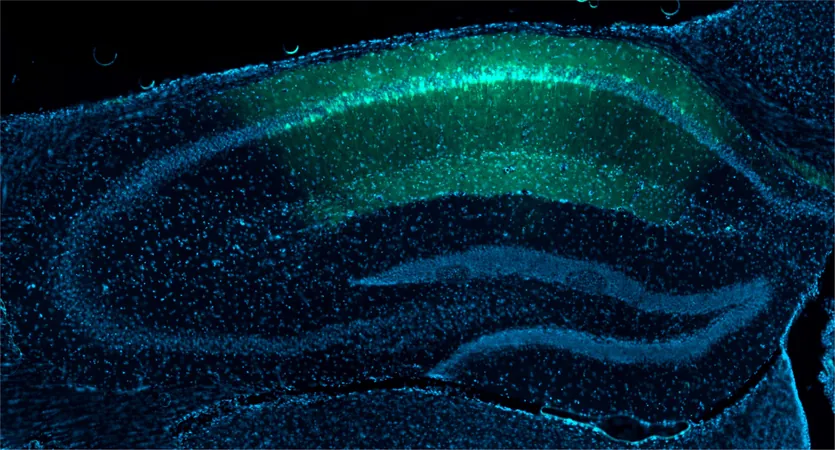
Unlocking the Secrets of the Brain: How Rewards Shape Our Actions in Addiction and Dementia
2025-06-11
Author: Rajesh
Picture this: you're on your daily commute, ready for that comforting cup of coffee, only to find your favorite cafe closed. You stumble upon a new coffee spot nearby and, much to your surprise, it turns out to be a hidden gem! Before long, this new routine has you buzzing with excitement.
But this intriguing shift in your day doesn’t just change your caffeine fix; it also engages a fascinating neural map in your brain that records rewarding experiences. This map helps guide you back to those feel-good moments, allowing you to retrace your steps to happiness even from afar.
Recent groundbreaking research by scientists at Stanford's Wu Tsai Neuro lab using mice has unveiled that this reward map is not just a theoretical construct—it’s real and adaptable. It was revealed that this neural circuitry updates almost instantly when a reward’s location changes, a finding that could have profound implications for understanding dementia, addiction, and animal behavior.
"We moved the reward around, and astonishingly, the neural map adjusted immediately," stated Lisa Giocomo, a neurobiology professor and deputy director at Wu Tsai Neuro. "I never anticipated such swift adaptability!"
Inside the Lab: Unveiling Neural Activity
To delve into how these rewarding experiences are encoded, Giocomo and her team pioneered an innovative approach: they replaced part of a mouse’s skull with a transparent window! This ingenious setup allowed them to use advanced two-photon microscopy to observe the activity of neurons in real time within the hippocampus, the brain’s hub for memory and navigation.
The process was more like an IMAX experience than a VR for mice—while scurrying on wheels, the little critters explored a virtual environment projected onto giant monitors. When they approached specific spots in the simulated world, a sweet drop of sugar water awaited them, and the researchers adjusted this virtual reward’s location.
Mapping Memory: The Dance of Neurons
As predicted, a population of neurons maintained a stable layout of the environment. Surprisingly, another group of neurons showcased remarkable flexibility, switching on and off as the reward’s location changed. This adaptability provides an essential survival strategy for mice navigating the wild.
Interestingly, these neural maps are not entirely separate; neurons from the spatial map can engage with the reward map, enhancing the animal's ability to adjust quickly to new circumstances.
Real-World Implications: Addiction and Dementia
The implications of these findings extend beyond mice! Researchers suggest that humans may similarly categorize locations tied to future rewards distinct from everyday environments. This could explain why individuals with dementia struggle to remember the chronology of events or where they performed specific tasks—impaired connections between reward and spatial maps might be at play.
Moreover, in addiction cases, the powerful connections between rewarding experiences (like drug use) and specific locations can trigger relapse, posing significant challenges for recovery.
A Path Towards Healing: New Insights for Treatment
Understanding these intricate neural links could pave the way for innovative therapies aimed at weakening detrimental cravings linked to specific environments, or conversely, strengthening connections for those battling dementia.
Giocomo emphasizes that their exploration is just beginning. They seek to uncover how these reward maps influence animals as they venture into new territories and whether similar mappings exist for social interactions.
"Are the places we connect with friends and social interactions charted in the same way? We believe the technology is finally at the stage to unravel such complex behaviors," she concluded.



 Brasil (PT)
Brasil (PT)
 Canada (EN)
Canada (EN)
 Chile (ES)
Chile (ES)
 Česko (CS)
Česko (CS)
 대한민국 (KO)
대한민국 (KO)
 España (ES)
España (ES)
 France (FR)
France (FR)
 Hong Kong (EN)
Hong Kong (EN)
 Italia (IT)
Italia (IT)
 日本 (JA)
日本 (JA)
 Magyarország (HU)
Magyarország (HU)
 Norge (NO)
Norge (NO)
 Polska (PL)
Polska (PL)
 Schweiz (DE)
Schweiz (DE)
 Singapore (EN)
Singapore (EN)
 Sverige (SV)
Sverige (SV)
 Suomi (FI)
Suomi (FI)
 Türkiye (TR)
Türkiye (TR)
 الإمارات العربية المتحدة (AR)
الإمارات العربية المتحدة (AR)